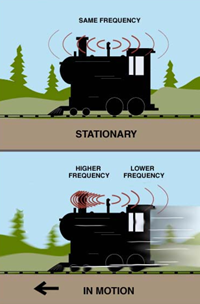    |
||||

The Doppler Effect |
||||
|
The Doppler effect (or Doppler shift) is named after the Austrian physicist Christian Doppler, who proposed it in 1842. It is the change in frequency of a wave experienced by an observer moving relative to the source of the wave.
Suppose now that the source starts moving directly toward us. When the source emits the next wave crest, it will be nearer to us, so the distance between the two wave crests arriving at our ears will appear to be smaller than when the star was stationary. This means that the wavelength of the waves we receive will be shorter than when the source was not moving... that means the frequency will be higher, making the sound of a higher pitch than when it was stationary. Similarly, if the source is moving away from us, the wavelength of the waves will appear slightly longer, the frequncy and pitch therefore lower. The relationship between wavelength and speed is called the Doppler effect. We experience it every day, not only sirens, but engine sound as cars appraoch and pass you on the highway. You are so used to it you may not even notice it - but the Doppler Effect is how you can tell whether a can is coming towards you or going away... the frequency also gives you an indication of its speed!
Light and sound are both waves and exhibit this effect. You will find out more about this effect happens for light waves as well as sound waves when you study the red shift section of your course. |
||||
 |
||||




